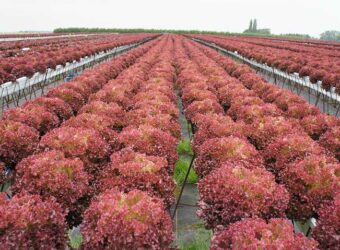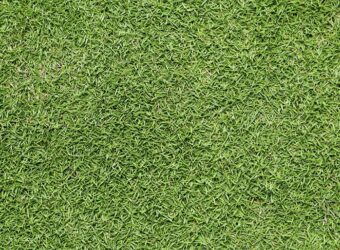If you see slime trails in your garden, notice tender seedlings have disappeared overnight, or observe chewed holes in your plants, you may be dealing with slugs. These slimy mollusks can cause serious damage to vegetables, flowers, and other garden plants.
Over the years, I’ve dealt with my fair share of slug outbreaks and tried out lots of control methods along the way. And some have proved more effective than others.
I’m going to introduce you to basic slug biology, signs that you may be dealing with slugs, and some of my favorite slug control methods.
Are Slugs in the Garden Good or Bad?
While labeling every garden critter as bad is easy, it’s important to recognize that some insects and invertebrates help keep your plants healthy. With that said, slugs are garden pests.
Slugs of all sizes feed on plants, including vegetables and flowers. While a few slugs won’t cause major damage, these critters often arrive in mass and can quickly defoliate your plants.
What Are Slugs?
Before diving into how to control slugs, let’s learn more about them. Are slugs insects? Are they just snails without shells?
Slugs aren’t insects. Instead, they’re gastropods.
Both slugs and snails are gastropods, but snails contain shells, and slugs don’t.
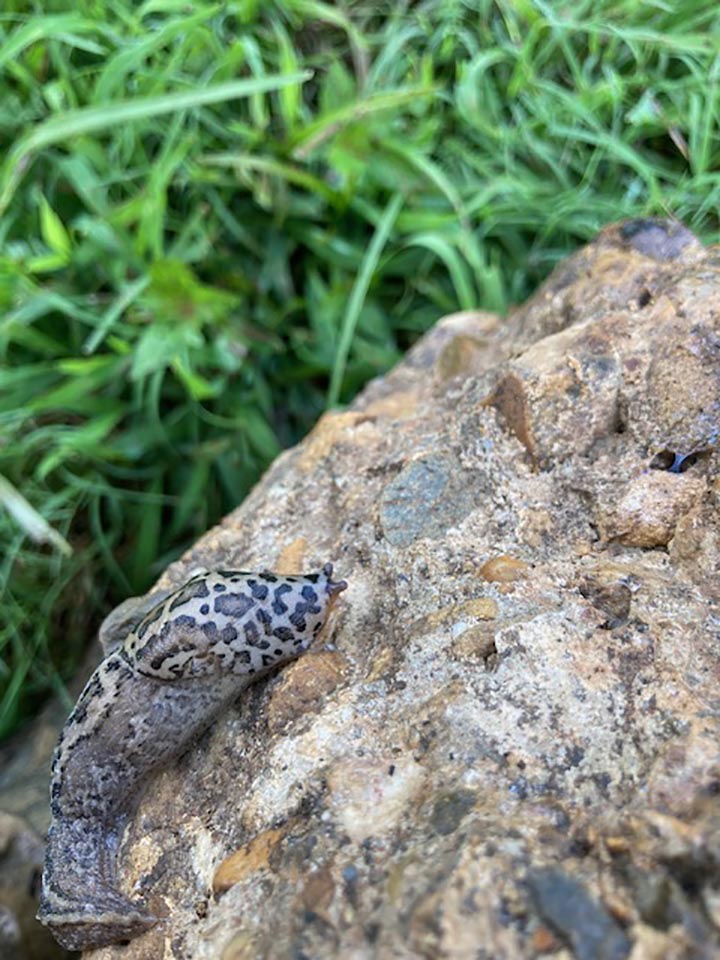
All slugs have a muscular ‘foot’ that they use to propel themselves along. On top of the foot is a structure called the mantel, which contains the slug’s organs. Most slugs also have two pairs of tentacles; they use one for sensing light and the other for smelling.
Slugs have soft bodies and produce a layer of slime to protect them from their environment and keep them from drying out. They leave a slime trail along the ground, making it easy to spot their path.
There are many different species of slugs that vary in size, color, and feeding habits. However, many slugs are opportunistic eaters and will feed on plants, fungi, and even dead insects.
Where Do Slugs Come From?
If you suddenly spot an influx of slugs in your garden, you’re probably wondering where they came from. Learning how slugs enter your garden can help answer this question and understand how to control these pests.
I’ll dive into the slug life cycle below, but if you learn nothing else, you should understand that slugs hatch from eggs. While pests like aphids, cucumber beetles, and squash bugs can fly into the garden from other areas, slugs are not great travelers.
Therefore, a sudden influx of slugs is likely the result of recently hatched eggs rather than the arrival of adult slugs.
The weather can also impact the prevalence of slugs and the damage they cause. These critters like dark and moist environments, so you’ll often notice increased slug activity after a few cloudy and rainy days.
Understanding the Slug Life Cycle
When I discover a new pest in my garden, one of my first steps is to research the pest’s life cycle. This allows me to understand where the pest lays its eggs, how many life cycles it completes each year, what the juveniles eat, how the pest overwinters, and so on. Once I understand these topics, I can understand how to control each pest.
So, let’s dive into the slug life cycle!
As I mentioned above, slugs begin their lives as eggs. Adult slugs lay clusters of round eggs that resemble small tapioca pearls. They lay their eggs in cracks and holes in the soil or under debris like wood and plant material.
The time it takes for the eggs to hatch depends on the temperature. In the summer, eggs can hatch in as little as two weeks. However, eggs laid in the late fall may not hatch until the weather warms up following spring.
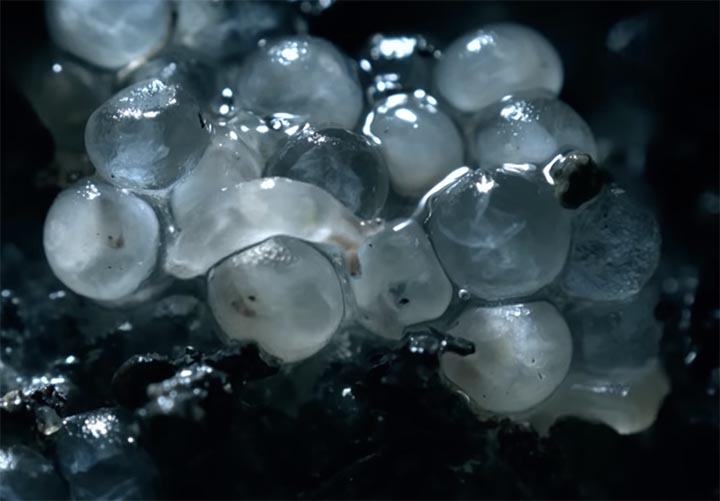
The eggs hatch into small slugs known as neonates. These little slugs often feed on algae and fungi, but they can also consume plants. The neonates then grow into juveniles and finally adults.
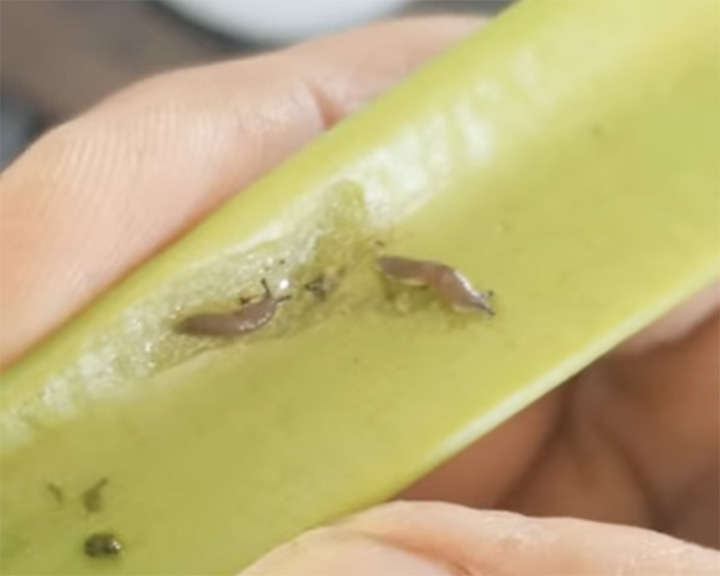
It’s important to note that slugs are born as hermaphrodites, meaning they have both male and female reproductive organs. That means that every slug can lay eggs and fertilize their own eggs.
Most adult slugs lay eggs in the late summer to fall, and the eggs hatch the following spring. However, some slug species lay their eggs throughout the summer and into fall.
Conditions that Favor Slugs
While slugs can appear just about anywhere, they favor certain types of environments. Preventing these environments in your garden can help keep slugs away.
First off, slugs need hiding places to protect them from the sun and predators. These critters love to hide in moist, dark places such as under logs and rocks, throughout weeds and mulch, and in soil cracks.
Since slugs lay their eggs in the soil or near the soil surface, they also thrive more in no-till areas than in heavily tilled areas.
When Do Slugs Damage Plants?
Slugs typically emerge from their hiding places during the early morning, evening, and night. That means you may see slug damage but not the actual slugs.
However, slugs sometimes become active during cloudy or damp days.
While slugs don’t like the blazing sun, they are only active above certain temperatures. If temperatures are below 40°F, slugs will not move around or feed.
Since they don’t like hot sun nor cold temperatures, slugs are most often a threat in the cool, damp periods present during the spring and summer.
Signs of Slugs in the Garden
As I mentioned above, slugs are most active at night. So you may not see them unless you’re out in your garden after dark.

However, you can look for some signs of slugs during the day.
First, look for the slugs themselves. Since slugs like to hide in moist and dark areas, check under logs and stones in your garden. You can brush aside weeds and look for slugs on moist, cool ground.
If you spot slugs, there’s no denying that they’re in your garden. However, finding slugs isn’t always this easy.
You can also look for signs that slugs are damaging your plants.
Slug damage will vary depending on the size of the slugs as well as the type of plant. In general, slugs favor tender new growth over older plant material. That means you may notice your seedlings have holes chewed in them, but larger plants remain untouched.
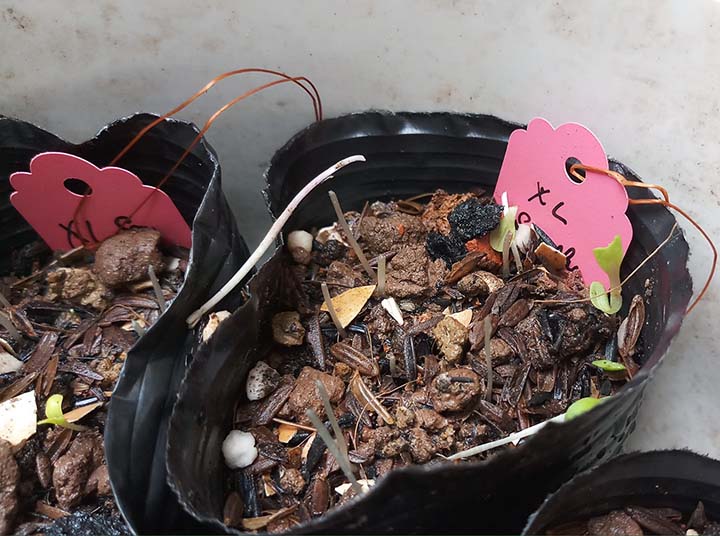
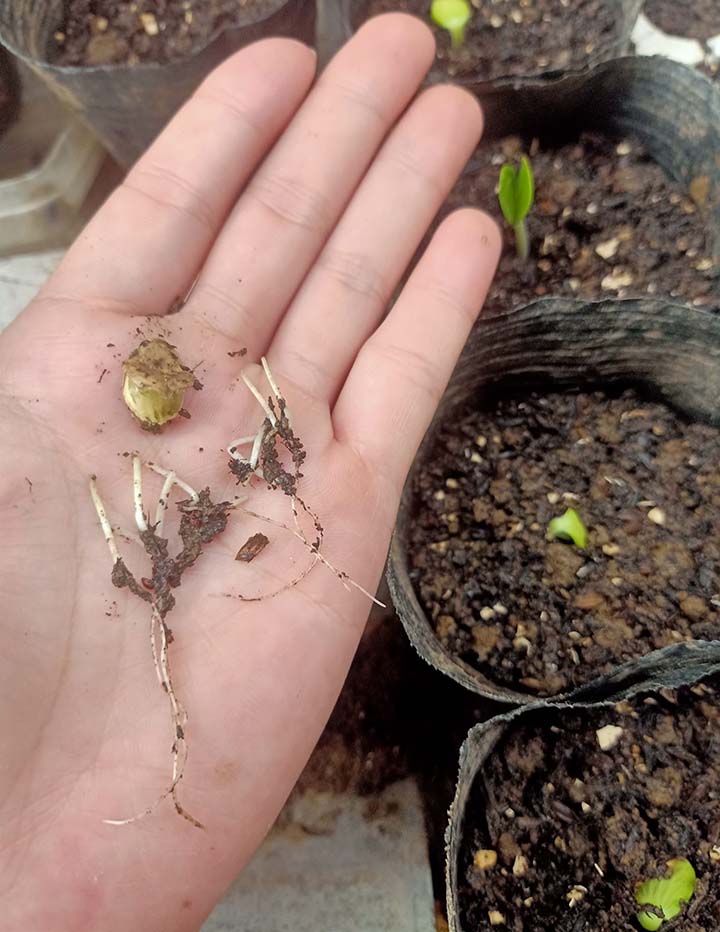
No matter what type of plant slugs feed on, damage appears similar. These critters use their rasping mouthparts to cut irregular holes out of plants. Slugs can eat both large sections of leaves or chew out multiple smaller holes in the same leaf.
Finally, you can also look for slug slime trails. Slugs leave behind a slime trail as they move, which often sticks around after the slugs have left the area. These slime trails can be partially helpful from differentiating slug damage from that of cutworms, cabbage worms, and other related pests.
Plants that Slugs Love
Slugs will feed on various plants, but they prefer tender new growth and soft fruits.
Strawberries are one of slugs’ favorite foods, and these critters seem to love to chew a single hole in just about every ripe fruit they see. They also like to feed on cucumbers and ripe tomatoes.
As far as leaves go, slugs will eat lettuce, radishes, spinach, peas, beans, and other tender veggies. They’ll also dine on flowers including petunias, zinnias, bellflowers, and more.
Slugs tend to avoid rough or fragrant plants such as lamb’s ear, wormwood, spurge, and yucca.
Reasons to Control Slugs
As I mentioned above, many types of slugs feed on plants. I’ve witnessed hoards of small slugs decimate lettuce seedlings and seen large slugs chew holes in bok choy plants.
If you fail to control slugs, the pests will only grow and continue to eat your garden plants.
Controlling adult slugs also helps prevent them from laying eggs. While you may think that larger slugs are more of a nuisance, I’ve noticed that the difficult-to-see neonates are sometimes more difficult to control.
One spring, I went to harvest butter lettuce heads that looked practically perfect. However, once I cut and washed the heads, I realized that the interior leaves had been shredded by tons of tiny slugs. Killing adult slugs can help prevent you from dealing with a situation like this.
How to Discourage Slugs?
As is the case with most pests, preventing slugs is often easier than controlling them once they occur.
Limit Weed Growth
Since slugs like to hide in dark and moist areas, weeds create just the type of habitat they love. Removing weeds both in your garden and near the garden edges can help keep slugs away.
If your garden is surrounded by a lawn, it’s also a good idea to keep the grass short.
Avoid Mulch
While mulch has many benefits, it can also provide an ideal habitat for slugs. The pests can crawl under and between pieces of mulch during the day and then emerge to feed at night.
All types of mulch provide a protective habitat for slugs, including wood mulch, straw, and landscape fabric.
Regularly Disturb the Soil
Since slugs lay their eggs in the soil and often hide in the ground, tilling or vigorously raking the soil can discourage slugs from calling your garden home. However, it is possible to use other means to control slugs in no-till environments.
Encourage Natural Predators
Fortunately, there are many natural slug predators. Frogs, toads, birds, lizards, shrews, turtles, ground beetles, and firefly larvae all feed on these gastropods.
Building a habitat that favors these predators will increase the chances they will call your garden home. However, there is a bit of overlap between a slug’s ideal environment and a predator’s ideal environment, so act carefully.
In general, slug predators have a larger range than slugs. Therefore, you can put wild protective areas twenty or so feet away from your garden to attract predators but not slugs.
Adding small ponds, hedgerows filled with native plants, and perches for birds will help make predators happy.
Avoiding broad-spectrum insecticides is another way to keep predatory insects in your garden.
How to Control Slugs in the Garden?
Once you recognize that slugs are eating your garden plants, you should take action ASAP. Working quickly will help you stop damage from occurring and also help prevent future generations of slugs from emerging.
If you scour the internet or ask a neighbor how to control slugs, you may hear one of a dozen or more solutions. Salt, bleach, coffee grounds, eggshells, vinegar—you name it, and people have tried it!
While you can control slugs in the garden in multiple ways, some methods work better than others.
Physically Remove Slugs
One way to protect your garden from slugs is by physically removing them from your garden. This method works best if you have a small garden and aren’t dealing with a major outbreak.
While you can head out with a headlamp and search for individual slugs, there are easier ways to find these often elusive critters. Remember how they like dark and moist areas? Well, you can use this to your advantage.
Start by laying a small piece of plywood or lumber flat against the ground. Within a few days, slugs will crawl under the board during the day. Now your job is easy!
Lift up the board and toss any slugs into soapy water or a 1:1 water-to-vinegar solution. Continue to repeat this method until you don’t see any slugs beneath the board.
If you have a larger garden, consider placing a board about every ten feet or so.
Prevent Slugs from Reaching Your Plants
Other control methods don’t aim to remove slugs completely but rather keep them away from plants you want to protect. This method works well if you have a small garden or are growing plants in containers.
One way to keep slugs away is by using materials that damage their soft bodies. If you’ve ever felt a slug, you know they have a jelly-like consistency. Their slime protects them from much of the world, but sharp fragments can damage the slug’s bodies.
Diatomaceous earth (DE) is one of the best materials for forming a barrier against slugs. While it may sound scary, DE is made from fossilized water-dwelling creatures called diatoms.
It’s harmless to humans and pets (unless it’s inhaled), making it a great option if you have curious hands and mouths around. Plus, it doesn’t harm waterways or other parts of the environment.
So, if DE is harmless to larger creatures, how does it help control slugs? When slugs come into contact with DE, they begin to become uncomfortable. Therefore, they will turn around before they cross a line of DE.
However, the DE does not kill the slugs. Therefore, you must continue to reapply this material around your plants if you want it to act as an effective control. Additionally, wet DE does not affect slugs, so you must reapply the material after it rains.
Trap Slugs
Another way you can control slugs is by trapping them. Beer traps are a popular option, but people also use sugar water, yeasted water, fruit juice, and other sweet substances.
Creating a basic slug trap is easy. Dig a small hole and place a container in the hole so the top is flush with the soil surface. Next, fill the container with your substance of choice.
In theory, the slugs will be attracted to the liquid and come to drink. When they begin sipping on the liquid, they will fall in and drown.
But does this really happen?
While slugs are attracted to beer and sugary liquids, these traps don’t necessarily kill the slugs. Sometimes the pests show up to the traps, drink their fill, then head on their merry way. Want proof? Check out this video.
Use Slug Bait
Another way to kill slugs is by attracting them with poison baits. Slugs eat this material and then die within a few days.
One of the most popular slug baits is Sluggo, which is made from iron phosphate. Once slugs eat the bait, they stop feeding and die in about a week. Although this product is harmful to slugs, it does not harm pets and humans, unless they consume large amounts.
Since Sluggo bait dissolves in water, you will need to reapply the product after heavy rains.
Another type of slug bait contains metaldehyde. One example is Southern Ag Snail & Slug Bait. After slugs eat this bait, they die within a few days.
This product not only affects slugs, but is also harmful to mammals and general predators. If pets consume the bait, they can develop symptoms including tachycardia, dilated pupils, and excessive panting.
My Favorite Ways to Control Slugs
I said it before, and I’ll say it again, people claim all kinds of methods will work to control slugs. However, I’ve found that many of these control methods are nothing more than myths.
So, what’s one to do? Turn to proven methods, of course!
With my years of growing vegetables, as I’ve watched little slugs munch on tender lettuce leaves and devour beet seedlings, I’ve learned how to properly control these pests.
For Controlling Slugs Eating Your Plants: Sluggo
If I notice slug damage in my garden, I turn to Sluggo. It works on all sizes and types of slugs, and is appropriate regardless of if the pests have begun to eat your plants.
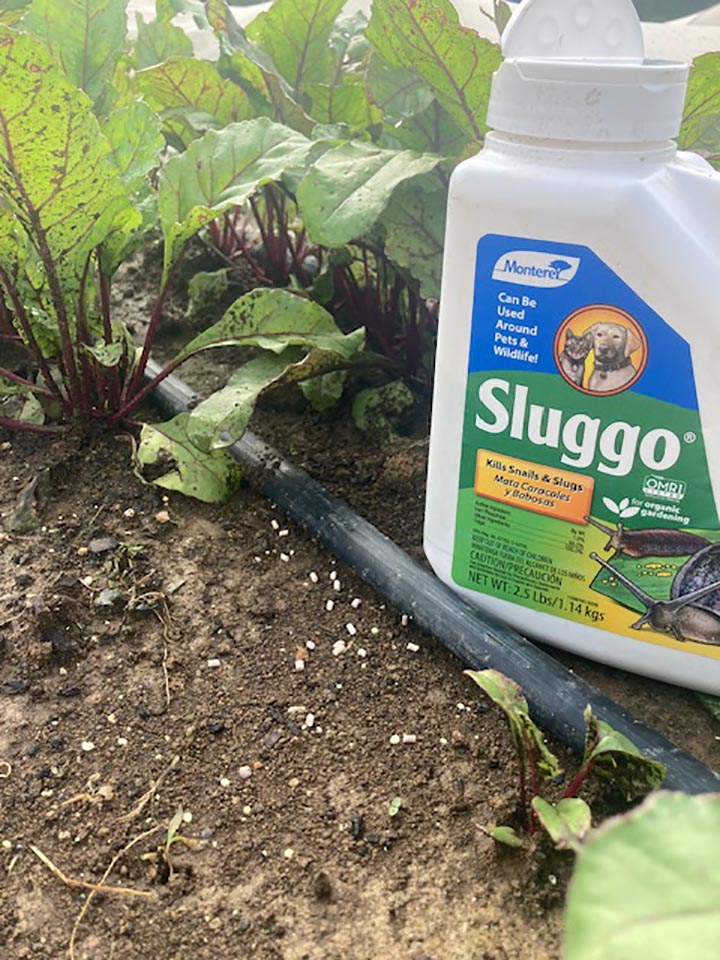
So, how does it work? Slugs readily seek out this granular bait and ingest it. This material damages the slug’s digestive tract and stops them from eating. Typically, they die a few days after ingesting the bait.
While Sluggo is a pesticide, it is an organic option that doesn’t present major harm to beneficial insects, children, or pets. That’s because it’s made from iron phosphate, a compound that combines iron, phosphorus, and oxygen.
Iron phosphate is sometimes used to fortify bread and cereal and is not harmful when ingested in small quantities. However, you should keep pets and children away from the product container.
Sluggo is also harmless to the environment, as long as you use it in small quantities. When it comes into contact with water, it breaks down into iron and phosphate, both of which are harmless in small amounts.
When you apply Sluggo, it’s important to remember that slugs don’t travel long distances. Applying a few granules every foot or so will increase the odds that all slugs eat the bait.

It’s fine to apply Sluggo throughout your entire garden, but you can also apply it just around affected plants. Applying it around the perimeter of your garden will also impact slugs that are entering from lawns and weedy areas.
You can also use Sluggo to get rid of slugs in your lawn.
For Immediate Slug Control: Handpicking
While Sluggo works quickly, it doesn’t work instantly. If I spot slugs munching on my plants, sometimes I want to remove them and kill them on the spot.
When that’s the case, I hand pick the slugs off the plants and place them in a bucket filled with soapy water. After the slugs have died, I dispose of them.
It’s important to remember that many slugs hide during the day, so handpicking will unlikely remove all the slugs from a garden. However, it can decrease slug numbers.
Frequently Asked Questions
Do Coffee Grounds Deter or Kill Slugs?
Coffee grounds do not have a major effect on slugs. While some people say slugs are hesitant to cross the sharp grounds, the critters will crawl over coffee grounds without hesitation.
Does Copper Tape Deter Slugs?
Some people may say slugs are hesitant to cross copper, but this isn’t true. While copper tape may slightly deter slugs, it will not keep them out of your garden nor kill them.
What Instantly Kills Slugs?
If you spot a slug in your garden and want to kill it instantly, you can drop it in salt, vinegar, borax solution, or soapy water.
What Are Pet-Friendly Ways to Get Rid of Slugs?
Removing slugs by hand and placing them in soapy water or vinegar is a pet-safe way to control slugs. You can also apply an iron phosphate slug bait such as Sluggo. While pets may become sick if they eat large quantities of iron phosphate, it is harmless in small amounts.
Control Slugs with Confidence
If you notice slugs are munching on your garden or lawn, you now know how to properly control them. Remember to act quickly and reapply bait as necessary.

